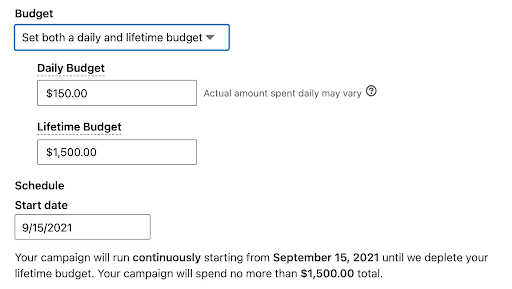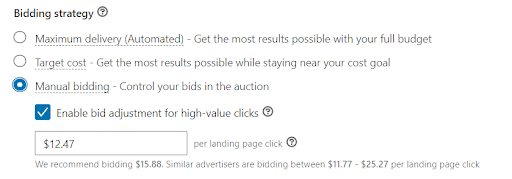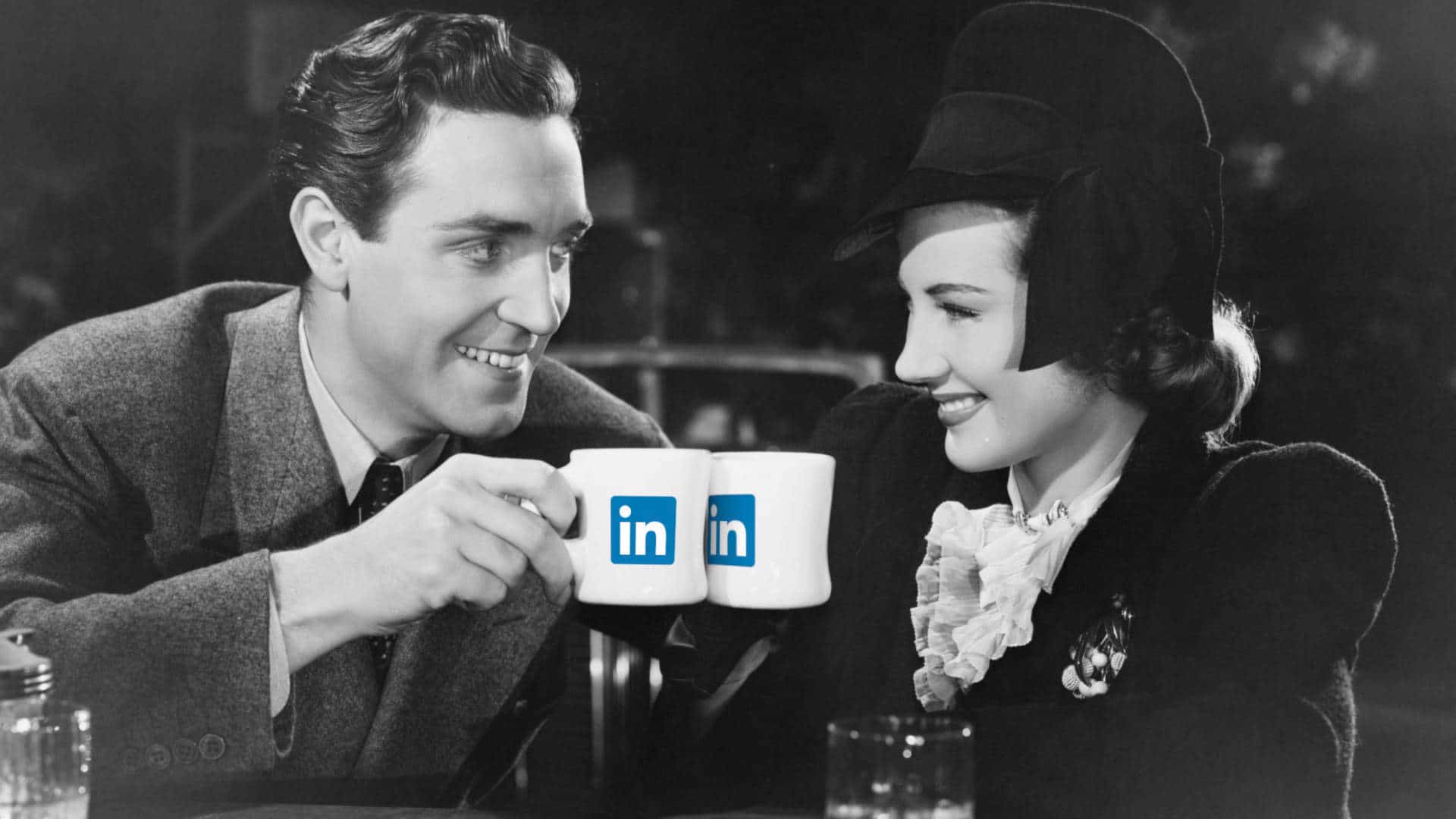
Success with LinkedIn ads depends on various factors, from reaching your ideal audience to promoting the right offers to the right people.
Understanding how LinkedIn bills for your ad campaigns plays a big part in determining your LinkedIn ads strategy.
How much you pay LinkedIn is a factor of your budget and your bids. When you pay LinkedIn depends on whether you use credit card or invoiced billing.
In this article, we’ll dive into:
- Setting LinkedIn Ads Budget
- Bidding
- Billing Frequency and Methods
Follow these guidelines so you can correctly plan for the costs of your LinkedIn campaigns and get the most out of your investment.
Setting LinkedIn Ads Budgets
LinkedIn ads allow you to set a daily budget, a lifetime budget, or both.
When setting a daily budget, you may be surprised to learn that LinkedIn can charge you up to 50% higher than your daily budget on any given day. However, the costs will average out.
LinkedIn won’t charge you more than your daily budget multiplied by the number of days set for your campaign if your campaign has specific start and end dates. If your campaign is set to run continuously, LinkedIn won’t charge you more than 7 times your daily budget in any given week (Monday – Sunday).

Here’s an example: Let’s say you set your campaign’s daily budget to $100/day with a schedule of September 1 – September 30. On any given day, LinkedIn may charge you up to $150, but over the 30 days of your campaign, you won’t be charged more than 30 x $100 = $3,000.
A lifetime budget gives LinkedIn more flexibility to optimize your spending across the lifetime of your campaign. The advantage of this approach is that LinkedIn can serve significantly more impressions to your target audience on days when they are more active on the platform.

However, with a lifetime budget, you give up some control. Depending on your audience’s activity, LinkedIn may weight your spending to the early days of your campaign, giving you fewer opportunities to make adjustments based on performance.
Fortunately, LinkedIn also gives you the option to set both a daily budget and a lifetime budget. This option is only available for continuously running campaigns, so you can’t set a start and end date for these campaigns. Combining a daily and lifetime budget can provide you with safeguards against overspending.

For example, let’s say you’ve budgeted $10,000 for a campaign and set the daily budget to $500/day. You could easily exceed your planned amount if you forget to stop the campaign before the 20th day. By setting a lifetime budget, you’re enabling LinkedIn to pause your campaign before that happens. On any given day, you may still be charged 50% above your daily budget, but over your campaign’s lifetime, you won’t exceed your lifetime budget.
For more information, here is LinkedIn’s Campaign Budgets Overview.
Bidding
When it comes to bidding, there are two things for you to decide: What you are going to bid on and how you’re going to bid.
Depending on the ad format, LinkedIn gives you the following options for what to bid on:
- CPC or cost-per-click is the most common bidding method and charges you when a user clicks on your ad.
- CPM or cost per 1,000 impressions charges you for every 1,000 impressions your ad receives.
- CPV or cost-per-view charges you each time someone plays your video.
- CPS or cost-per-send is used with message campaigns and is the amount you pay for each message sent.
After you’ve determined what you’re bidding on, your next decision is to decide how to bid. LinkedIn gives you three types of bidding:
- Maximum delivery (automated)
- Target cost
- Manual bidding.
Maximum Delivery
Maximum delivery is an automated method of bidding that uses machine learning to maximize the efficiency of your budget. This bidding strategy aims to generate the most results for your campaign within your budget. Maximum delivery bidding charges by impressions (CPM) with no option to set a bid or cost cap.

Target Cost
LinkedIn’s system will automatically adjust your bid with target cost bidding to deliver the best possible results while staying within your target cost range. Depending on your campaign objectives, you can be charged by impressions, landing page clicks, engagement clicks, or video views.
Target cost bidding will not allow the average cost of your campaign to exceed 30% above the target cost that you set for the campaign. For example, suppose you set a target cost of $10 per click. By the end of the day, your average cost per click could be up to $13 per click (i.e., 30% higher than what you set).

Manual Bidding
Manual bidding gives you the most control over your bid amount, allowing you to specify how much you’re willing to pay for a key result. Depending on your campaign objective, LinkedIn may still “flex” this bid amount.
For example, if you set your optimization goal to leads or website conversions, LinkedIn may adjust your bid by 45% at any given time. However, throughout your campaign, your average cost won’t significantly exceed your bid amount.

At CommonMind, we prefer manual bidding because it gives us the most control over spend and the efficiency of our spend.
Billing Frequency and Methods
LinkedIn offers two different methods of payment: Credit card payment and invoicing.
Credit Card Payments
When opting to pay by credit card, the billing frequency is based on what your overall balance reaches. If your balance reaches $100.00 USD or more, you’ll be charged daily. If you reach between $20.00 and $99.99 in spend, you’ll be charged weekly. Finally, if your total spend is less than $20.00, you’ll be billed monthly.
Invoicing
With invoicing, you’ll be able to run ads up to a predetermined limit for 30 days. After 30 days, you’ll receive an invoice. This gives you a flexible monthly budget up to your approved amount.
LinkedIn requires an application and has an approval process for invoicing. You’ll first need to spend $3K/month for at least two consecutive months of the last year to qualify. After that, you’ll need to go through their application process, where a credit check and a monthly limit will be issued.
The invoicing option isn’t available to all advertisers. If you see the option to apply for invoicing appear in the billing section of Campaign Manager, follow the steps there. Otherwise, you may still be able to switch to invoiced billing by contacting LinkedIn billing support.
LinkedIn Ads Billing Is Straightforward Once You Understand How it Works
LinkedIn ads billing is capped by thresholds. You’ll be billed according to how much you spend in a given amount of time.
Understanding this, along with your available bidding options, can help you understand how much you can realistically expect to spend on LinkedIn ads. Use this information to your advantage to strategize and plan out your LinkedIn ads campaigns in the future.
CommonMind Can Help With Your LinkedIn Ads Strategy
LinkedIn ads can be a lot for marketers to handle on their own, from understanding billing and bidding to creating a winning strategy for your campaigns. CommonMind can help you optimize for continual growth and set you on the right path. Don’t hesitate to reach out to us.
Share this
You May Also Like
These Related Stories

Why We Love LinkedIn Ads For Growing B2B Leads

How to See Competitor Ads on LinkedIn (Guide)
